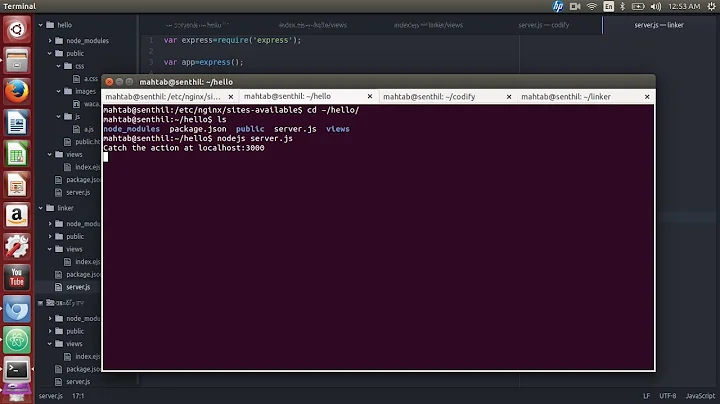Basic auth for a Tomcat app (JIRA) with Nginx as reverse proxy
Solution 1
Ok just found the solution on the nginx mailing list. I just had to tell nginx to not forward the auth headers to tomcat. Adding a couple of lines to the location blocks in nginx.conf did the trick:
location / {
proxy_set_header X-Forwarded-Host $host;
proxy_set_header X-Forwarded-Server $host;
proxy_set_header X-Forwarded-For $proxy_add_x_forwarded_for;
proxy_pass http://127.0.0.1:8090/;
proxy_redirect off;
# Password
auth_basic "Restricted";
auth_basic_user_file /home/passwd/.htpasswd;
# Don't forward auth to Tomcat
proxy_set_header Authorization "";
}
Now i just have to figure out how to prevent nginx from asking for auth on each subdomain (jira, confluence, stash, etc). Having to introduce the credentials just once for all of them would be perfect, but that's another issue.
Hope this helps!
Cheers.
Solution 2
I had the same problem with Confluence. This was very useful (both the updated question and SDude's answer). I have the proxy params on each sub-path level ("/jira", "/wiki" for Confluence, etc.), so I added proxy_set_header Authorization ""; to each location container in nginx config which fixed the problem. It also cured a weird problem with Stash where Stash was prompting for login password through a browser auth box rather than its own login screen. With the above it now displays the actual login screen.
Related videos on Youtube
Comments
-
sdude almost 2 years
I have several subdomains running the Atlassian Tomcat apps (jira.example.com, confluence.example.com, stash.example.com) and I would want to know if it is possible to password protect all of them with
basic_authwith.htpasswd.Nginx it is working ok without the basic_auth directive, but if I try to introduce it like this in
nginx.conf...user nginx; worker_processes 1; error_log /var/log/nginx/error.log; pid /var/run/nginx.pid; events { worker_connections 1024; } http { include /etc/nginx/mime.types; default_type application/octet-stream; log_format main '$remote_addr - $remote_user [$time_local] $request ' '"$status" $body_bytes_sent "$http_referer" ' '"$http_user_agent" "$http_x_forwarded_for"'; access_log /var/log/nginx/access.log main; sendfile on; #tcp_nopush on; #keepalive_timeout 0; keepalive_timeout 65; #gzip on; # Load config files from the /etc/nginx/conf.d directory include /etc/nginx/conf.d/*.conf; # Our self-signed cert ssl_certificate /etc/ssl/certs/fissl.crt; ssl_certificate_key /etc/ssl/private/fissl.key; # Password auth_basic "Restricted"; auth_basic_user_file /home/passwd/.htpasswd; # redirect non-ssl Confluence to ssl server { listen 80; server_name confluence.example.com; rewrite ^(.*) https://confluence.example.com$1 permanent; } # redirect non-ssl Jira to ssl server { listen 80; server_name jira.example.com; rewrite ^(.*) https://jira.example.com$1 permanent; } # # The Confluence server # server { listen 443; server_name confluence.example.com; ssl on; access_log /var/log/nginx/confluence.access.log main; error_log /var/log/nginx/confluence.error.log; location / { proxy_pass http://127.0.0.1:8080; proxy_set_header X-Forwarded-Proto https; proxy_set_header Host $http_host; } error_page 404 /404.html; location = /404.html { root /usr/share/nginx/html; } redirect server error pages to the static page /50x.html error_page 500 502 503 504 /50x.html; location = /50x.html { root /usr/share/nginx/html; } } # # The Jira server # server { listen 443; server_name jira.example.com; ssl on; access_log /var/log/nginx/jira.access.log main; error_log /var/log/nginx/jira.error.log; location / { proxy_pass http://127.0.0.1:9090/; proxy_set_header X-Forwarded-Proto https; proxy_set_header Host $http_host; } error_page 404 /404.html; location = /404.html { root /usr/share/nginx/html; } # redirect server error pages to the static page /50x.html # error_page 500 502 503 504 /50x.html; location = /50x.html { root /usr/share/nginx/html; } } }..it asks for credentials, but then it returns a
HTTP Status 401 - Basic Authentication Failure - Reason : AUTHENTICATION_DENIED
Looks like someone managed to fix this with apache running as reverse proxy http://jira.10933.n7.nabble.com/mod-proxy-and-password-protecting-td17279.html but those links in that thread are dead...
EDIT: Apparently this issue can be easily solved in Apache adding
tomcatAuthentication="false"and usingprotocol="AJP/1.3"within Tomcat's server.xml connector. Or you can prevent apache from forwarding the auth with the directiveRequestHeader unset authorization. Thing is, how to do it with Nginx? I guess I have to research more.. Any insights? -
equivalent8 about 10 yearsTHX this helped me with totally unrelated problem with combination NginX - Jenkins (Jetty server)
-
 skålfyfan over 8 years@equivalent8 pretty certain it just helped me fix the exact the same issue you had (nginx - Jenkins). Were you getting double prompted for authentication? Once by nginx, then by Jetty/Jenkins?
skålfyfan over 8 years@equivalent8 pretty certain it just helped me fix the exact the same issue you had (nginx - Jenkins). Were you getting double prompted for authentication? Once by nginx, then by Jetty/Jenkins? -
equivalent8 over 8 years@skålfyfan don't know dude that was year ago :) but I briefly remember that may be the case :)




